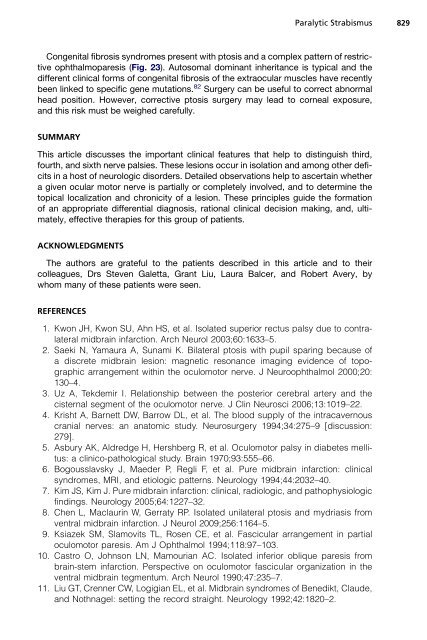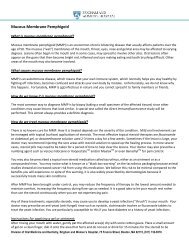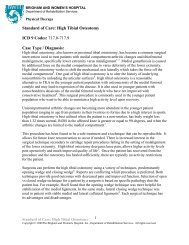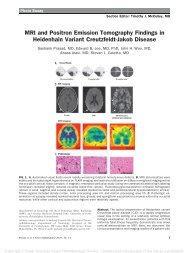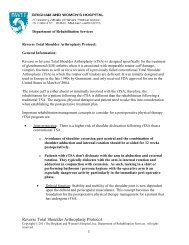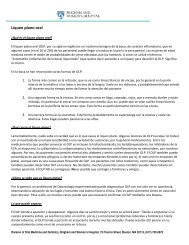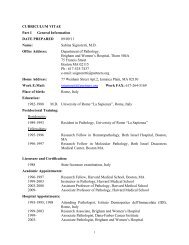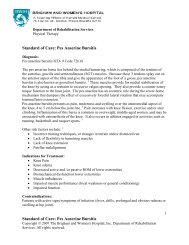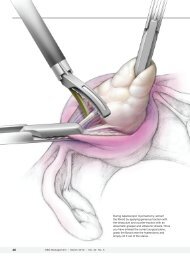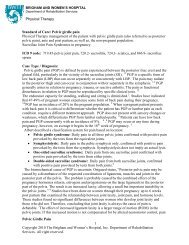Paralytic Strabismus: Third, Fourth, and Sixth Nerve Palsy
Paralytic Strabismus: Third, Fourth, and Sixth Nerve Palsy
Paralytic Strabismus: Third, Fourth, and Sixth Nerve Palsy
Create successful ePaper yourself
Turn your PDF publications into a flip-book with our unique Google optimized e-Paper software.
<strong>Paralytic</strong> <strong>Strabismus</strong> 829<br />
Congenital fibrosis syndromes present with ptosis <strong>and</strong> a complex pattern of restrictive<br />
ophthalmoparesis (Fig. 23). Autosomal dominant inheritance is typical <strong>and</strong> the<br />
different clinical forms of congenital fibrosis of the extraocular muscles have recently<br />
been linked to specific gene mutations. 82 Surgery can be useful to correct abnormal<br />
head position. However, corrective ptosis surgery may lead to corneal exposure,<br />
<strong>and</strong> this risk must be weighed carefully.<br />
SUMMARY<br />
This article discusses the important clinical features that help to distinguish third,<br />
fourth, <strong>and</strong> sixth nerve palsies. These lesions occur in isolation <strong>and</strong> among other deficits<br />
in a host of neurologic disorders. Detailed observations help to ascertain whether<br />
a given ocular motor nerve is partially or completely involved, <strong>and</strong> to determine the<br />
topical localization <strong>and</strong> chronicity of a lesion. These principles guide the formation<br />
of an appropriate differential diagnosis, rational clinical decision making, <strong>and</strong>, ultimately,<br />
effective therapies for this group of patients.<br />
ACKNOWLEDGMENTS<br />
The authors are grateful to the patients described in this article <strong>and</strong> to their<br />
colleagues, Drs Steven Galetta, Grant Liu, Laura Balcer, <strong>and</strong> Robert Avery, by<br />
whom many of these patients were seen.<br />
REFERENCES<br />
1. Kwon JH, Kwon SU, Ahn HS, et al. Isolated superior rectus palsy due to contralateral<br />
midbrain infarction. Arch Neurol 2003;60:1633–5.<br />
2. Saeki N, Yamaura A, Sunami K. Bilateral ptosis with pupil sparing because of<br />
a discrete midbrain lesion: magnetic resonance imaging evidence of topographic<br />
arrangement within the oculomotor nerve. J Neuroophthalmol 2000;20:<br />
130–4.<br />
3. Uz A, Tekdemir I. Relationship between the posterior cerebral artery <strong>and</strong> the<br />
cisternal segment of the oculomotor nerve. J Clin Neurosci 2006;13:1019–22.<br />
4. Krisht A, Barnett DW, Barrow DL, et al. The blood supply of the intracavernous<br />
cranial nerves: an anatomic study. Neurosurgery 1994;34:275–9 [discussion:<br />
279].<br />
5. Asbury AK, Aldredge H, Hershberg R, et al. Oculomotor palsy in diabetes mellitus:<br />
a clinico-pathological study. Brain 1970;93:555–66.<br />
6. Bogousslavsky J, Maeder P, Regli F, et al. Pure midbrain infarction: clinical<br />
syndromes, MRI, <strong>and</strong> etiologic patterns. Neurology 1994;44:2032–40.<br />
7. Kim JS, Kim J. Pure midbrain infarction: clinical, radiologic, <strong>and</strong> pathophysiologic<br />
findings. Neurology 2005;64:1227–32.<br />
8. Chen L, Maclaurin W, Gerraty RP. Isolated unilateral ptosis <strong>and</strong> mydriasis from<br />
ventral midbrain infarction. J Neurol 2009;256:1164–5.<br />
9. Ksiazek SM, Slamovits TL, Rosen CE, et al. Fascicular arrangement in partial<br />
oculomotor paresis. Am J Ophthalmol 1994;118:97–103.<br />
10. Castro O, Johnson LN, Mamourian AC. Isolated inferior oblique paresis from<br />
brain-stem infarction. Perspective on oculomotor fascicular organization in the<br />
ventral midbrain tegmentum. Arch Neurol 1990;47:235–7.<br />
11. Liu GT, Crenner CW, Logigian EL, et al. Midbrain syndromes of Benedikt, Claude,<br />
<strong>and</strong> Nothnagel: setting the record straight. Neurology 1992;42:1820–2.


